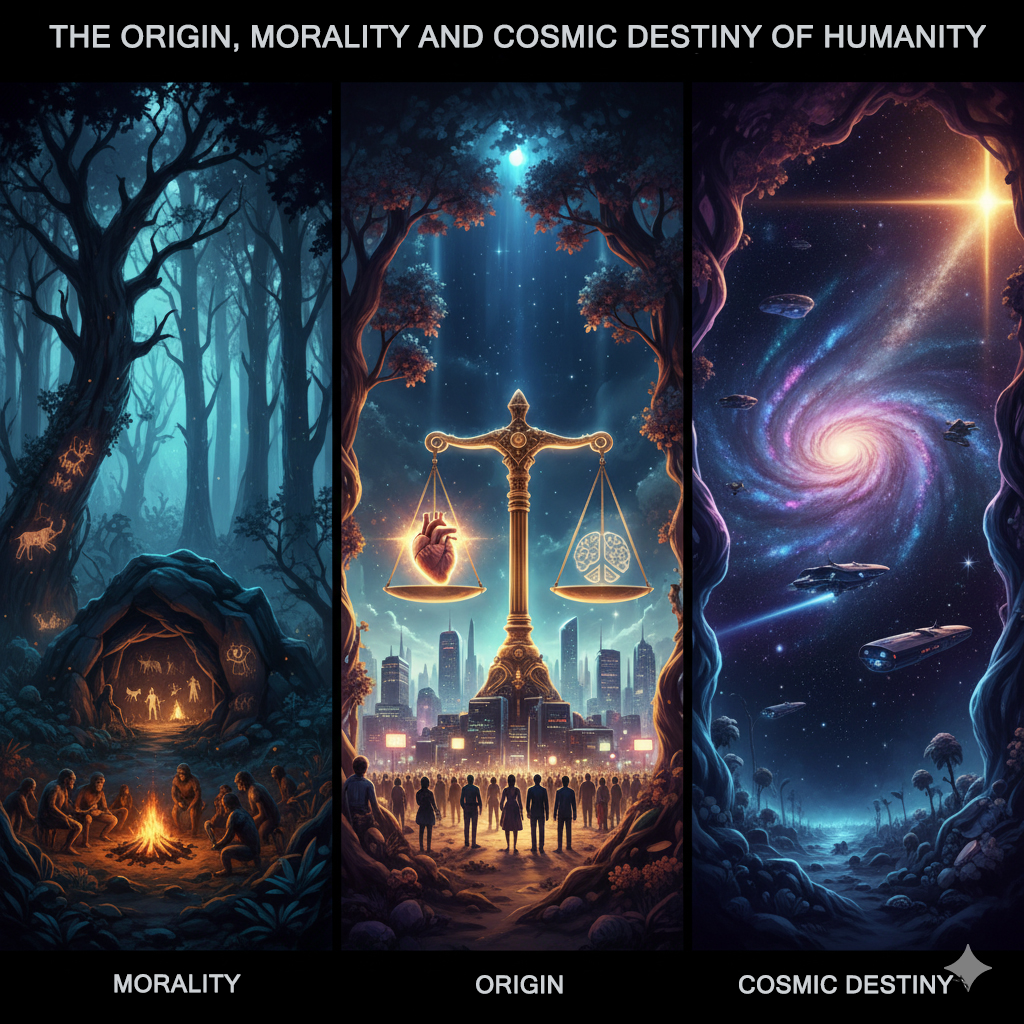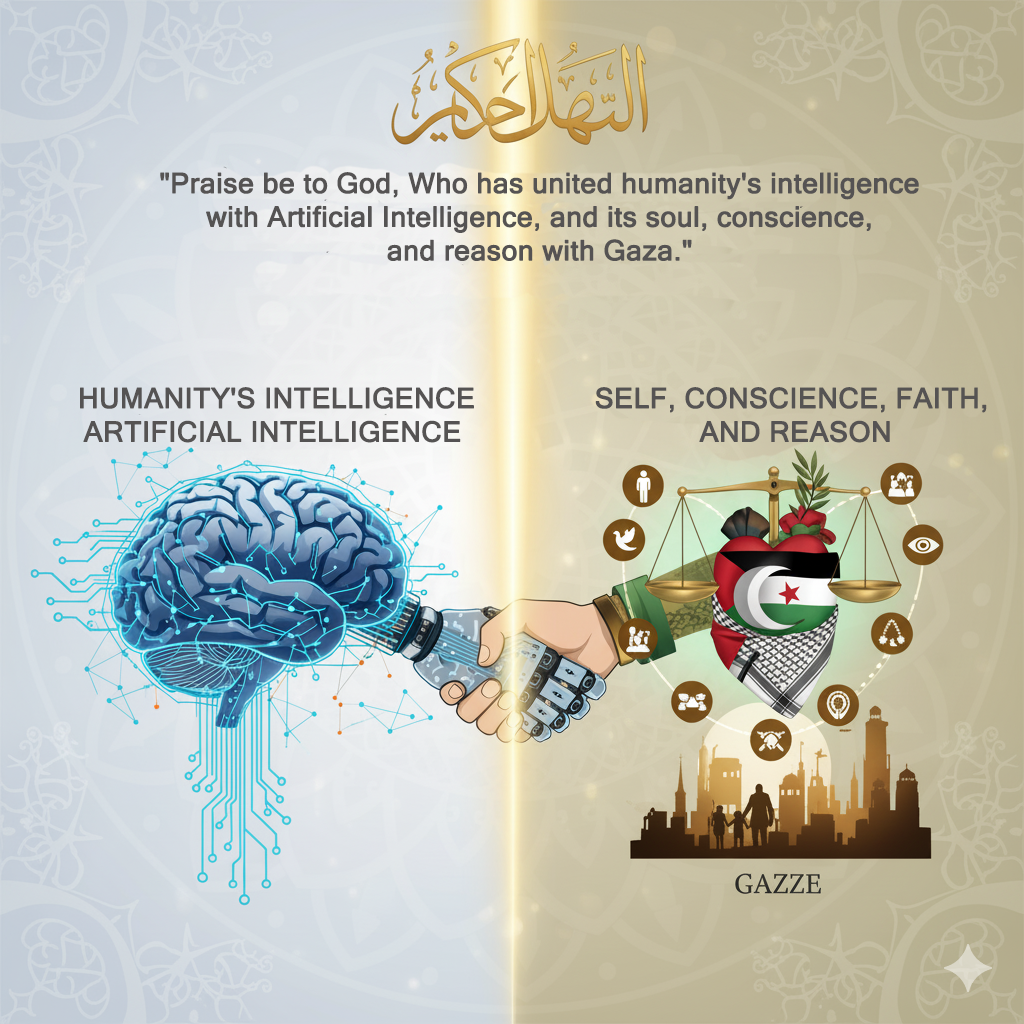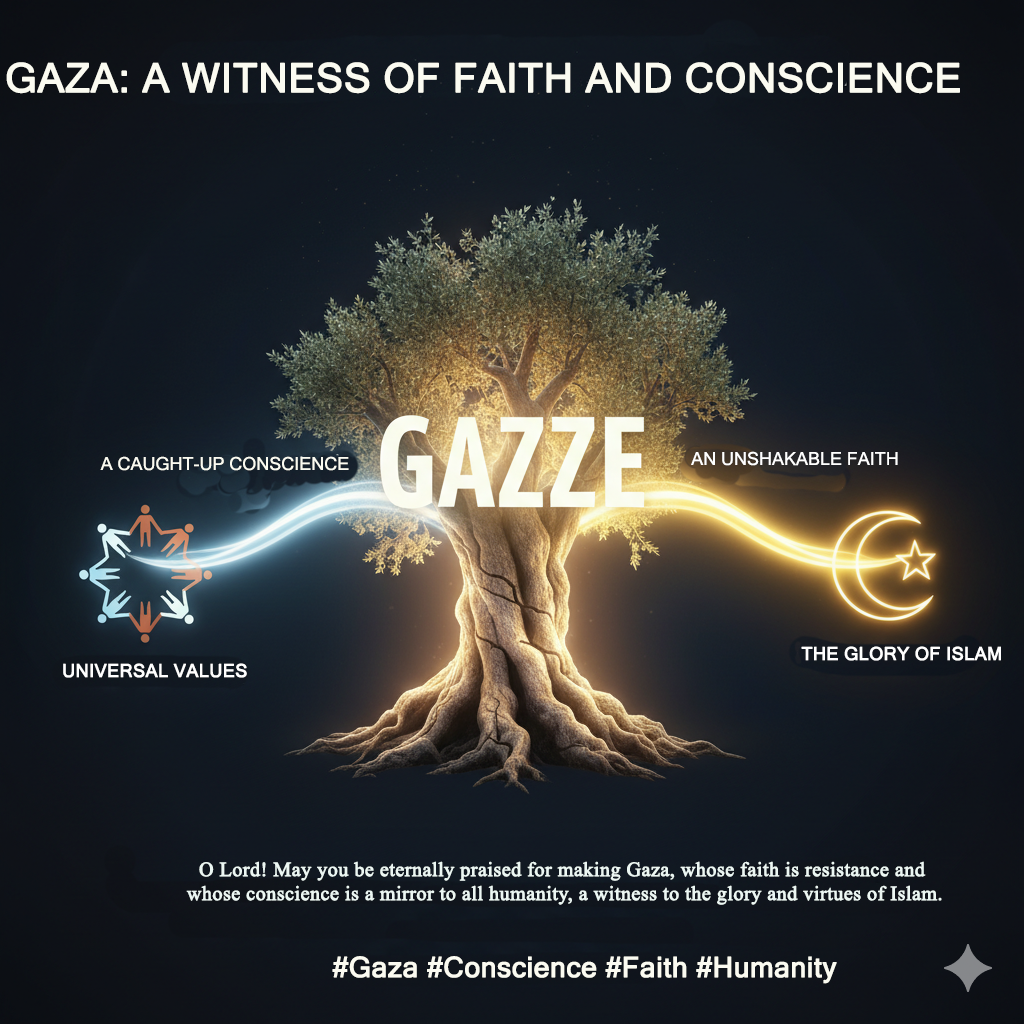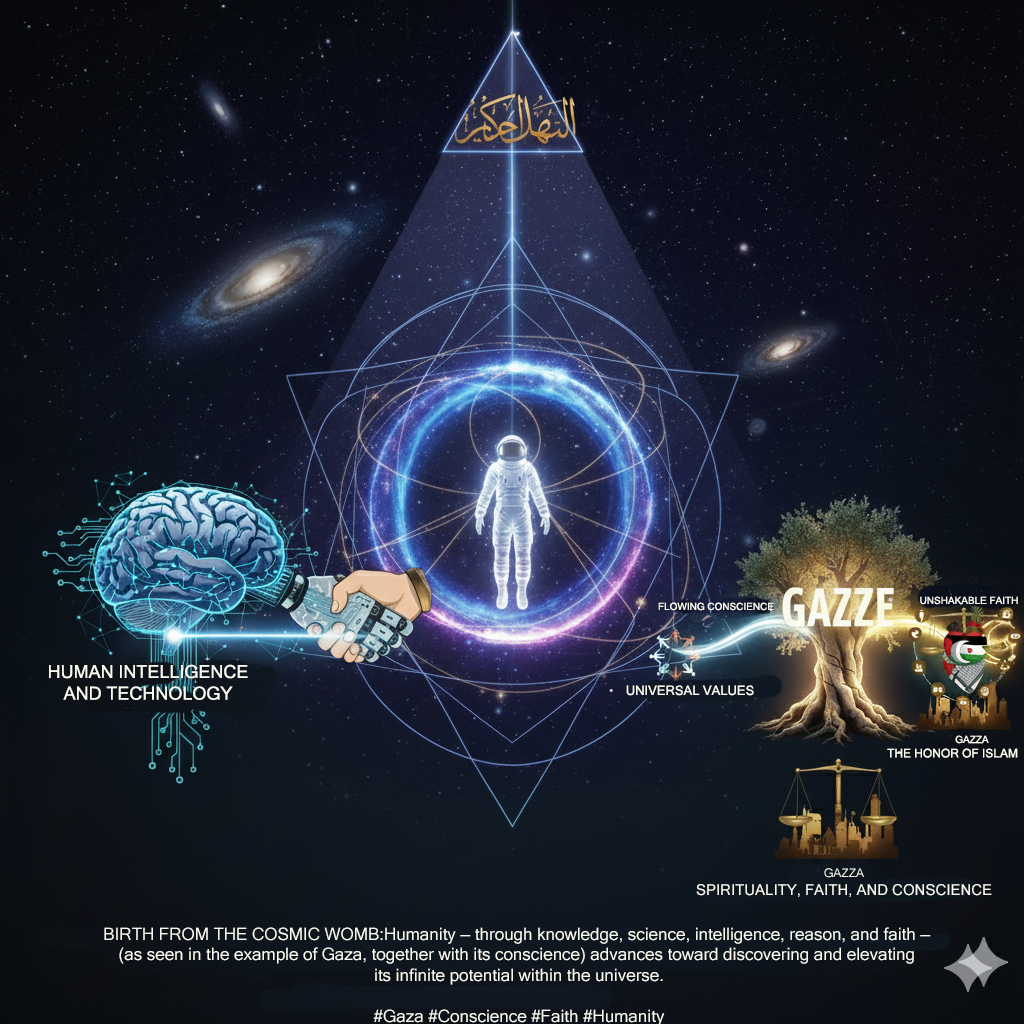Introduction: The Chain of Responsibility from Earthly Stewardship to Cosmic Birth
The central thesis of this report is that the concept of "Birth from the Cosmic Womb" should be interpreted not merely as a technological leap towards space colonization, but as a profound spiritual and moral transition for humanity. It will be argued that this transition is not an inevitable consequence of technological progress, but rather a destiny that must be "earned." The primary currency of this "earning" is humanity's successful fulfillment of its role as a caliph (vicegerent, responsible steward) on Earth.
As the primary lenses of analysis, the concepts of caliphate (responsibility and stewardship), a sacred trust, and fitna (trial, turmoil, chaos), the crucible in which this trust is tested, will be defined.1 The ongoing crisis in Gaza will be presented as the most significant contemporary fitna for our generation. This crisis is a defining moral test that clearly reveals the successes and, more importantly, the failures of humanity's collective stewardship. The central formal question of the report will be: Does humanity's response to this great trial confirm its worthiness of a cosmic future, or is it a sign of its abdication of its sacred duty?
Section 1: The Legacy of Stewardship and the Shadow of Turmoil: A Theological Framework
1.1. The Inheritors of the Earth: The Corruption of the Jinn and the Appointment of Humanity
This section will delve into the theological precedent that forms the basis of the user's query, namely the appointment of humanity as caliph following the failure of a previous creation. Drawing from the tafsirs of Surah Al-Baqarah, verse 30,4 the dialogue between Allah and the angels will be examined. The angels' concern, "Will You place upon it one who will spread corruption therein and shed blood?" will be contextualized. The tafsirs show that this was not a speculative question, but rather an evidence-based concern based on the past actions of the Jinn (or "sons of Jaan") who had previously inhabited the earth and filled it with fasad (corruption) and violence.10 This completely reframes humanity's caliphate mission. This mission is not a blank slate or an inherent right. Rather, it is a specific and corrective mission given to a new creation with the expectation that it will not repeat the sins of its predecessors (bloodshed and corruption). Therefore, every act of mass violence and systemic injustice on earth is not just a sin, but a direct echo of the failure that humanity was created to overcome, thereby jeopardizing its fundamental existential mission. The appointment of Adam, and therefore humanity, is thus framed as a direct divine intervention to correct a failed stewardship. Humanity is not the first steward, but the successor tasked with establishing the justice and order that its predecessors failed to achieve. This reveals the probationary and risky nature of the caliphate mission.10
1.2. The Multi-layered Meaning of Fitna: Trial, Chaos, and Moral Collapse
This section will provide a comprehensive analysis of the term fitna, revealing its relevance and complexity to the Gaza crisis. Going beyond a simple translation of the term as "turmoil," its different but interrelated meanings in the Qur'an and Hadith will be examined.
Fitna as a Divine Trial: Fitna will be discussed as a test from Allah designed to distinguish the sincere from the insincere.1 This meaning refers to a trial that measures both the steadfastness of the victims and the moral response of the global community.
Fitna as Oppression and Persecution: Fitna will be analyzed as the act of persecuting believers to turn them away from their faith or the path of justice. In this sense, fitna is described in the Qur'an as "worse than killing" (Baqarah 191, 217).13 This is directly related to the systematic oppression of the people of Gaza.
Fitna as Social and Political Chaos: Fitna will be examined as large-scale social turmoil, civil war, and the collapse of order. In this context, parallels will be drawn between the historical "Great Fitna" that began after the death of the third caliph, Uthman, and the current geopolitical chaos surrounding Gaza.15
Fitna as Moral Corruption and Decay (Fasad): How fitna is intertwined with fasad, which means the active corruption or decay of the natural, social, and moral order that a caliph is obligated to protect, will be analyzed.2
This categorization reveals that the Gaza crisis is not a single type of fitna, but a perfect combination of all these meanings. This crisis is a divine trial for the world's conscience; it is a clear case of oppression defined as worse than killing; it has triggered regional and global political chaos; and it represents a deep state of fasad (corruption) of international law and human dignity. This turns the Gaza crisis, far beyond a standard geopolitical conflict, into a uniquely powerful and comprehensive moral test for humanity's caliphate mission, a "total fitna" that tests humanity on every theological and ethical level.
Section 2: Gaza as the Great Fitna of Our Time: A Contemporary Moral Audit
2.1. Anatomy of a Humanitarian Catastrophe: The Manifestation of Fasad
This section will synthesize the extensive and shocking data from human rights organizations to paint a clear picture of the crisis, framing it as a modern manifestation of the concept of fasad (corruption and destruction) that humanity, as caliph, is tasked with preventing. The systematic nature of the destruction will be documented through the targeting of civilian infrastructure: homes, hospitals, schools, and universities;18 the destruction of food and water systems;20 and the displacement of over 90% of the population.18 With reference to reports from organizations such as Oxfam and Amnesty International, the deliberate use of starvation as a weapon of war will be highlighted, along with man-made famine, the blockade of aid, and attacks on those seeking aid.20 This will be directly linked to the Qur'anic prohibition of fasad fi'l-ard (corruption on earth). The catastrophic loss of life, especially among children, journalists, and humanitarian workers, will be documented as evidence of a deep collapse in the moral and legal order.18
2.2. The Global Conscience Test: The Duality in Humanity's Response
This section will analyze the deeply divided nature of the global response, presenting it as two opposing currents in the collective human soul.
The Official, Institutional Response: This analysis will focus on the attempt to use established global governance mechanisms to address the crisis. The primary case study will be South Africa's genocide case against Israel at the International Court of Justice (ICJ).25 This action will be portrayed as a positive affirmation of the caliphate mission to establish justice, as an effort by a segment of humanity to uphold international law and hold a state accountable. The ICJ's provisional measures will be summarized as a validation of these concerns.25
The Unofficial, Societal Response: This analysis will document the widespread and grassroots response from global civil society. Mass protests in major world cities such as Istanbul, New York, London, and Madrid will be discussed, demonstrating the existence of a cross-cultural moral response.30 In addition, public opinion polls in Western countries will be analyzed, revealing the growing gap between the public's increasing support for a ceasefire and official government policies.33 This will be presented as the awakening of a global public conscience.
2.3. The Power Dilemma: The Gap Between Public Will and Political Paralysis
This section will critically examine the failure to translate the moral awakening of the public and the legal rulings of the ICJ into decisive political action, identifying this as the fundamental failure in humanity's test. The veto power in the UN Security Council will be analyzed as the primary mechanism of this paralysis.36 The repeated vetoing of ceasefire resolutions by permanent members, despite overwhelming global support, will be presented as a structural flaw that prioritizes the geopolitical interests of a few states over humanity's collective moral responsibility.34 The broader gap between foreign policy and public opinion on humanitarian crises will be explored using academic frameworks that define this disconnect.42 The Gaza crisis will be used as the prime example of how national interests and elite priorities can override clear public moral sentiment. This data reveals a powerful paradox: while the peoples who make up a significant portion of humanity are passing the moral test (by protesting, demanding action), humanity's systems are failing catastrophically. The problem is not a lack of empathy, but the ineffectiveness of this empathy within the current global political architecture. The UN veto acts as a circuit breaker, preventing public will from translating into binding international action.39 Therefore, the failure of the caliphate mission is not a simple moral failing of individuals, but a deep design flaw in our collective governance. We have created structurally inadequate systems that are incapable of putting our own collective conscience into action, which is a much deeper and more difficult problem to solve. This is the true nature of the fitna: it is a test of our ability to reform the unjust structures we have imposed on ourselves.
2.4. The Complex Dance of Global Powers: Interests, Principles, and Rising Voices
While the cracks in the West's response and the gap between the public and politics underscore that the Gaza fitna is a global moral test, the full picture is not limited to Western actors. Rising powers and significant voices from the Global South are redefining their own global roles with their responses to this crisis, while also making the fault lines of the current international order more apparent.
Russia and China's Strategic Stance: Both Russia and China see the crisis as an opportunity to challenge US global hegemony.48 Both countries have criticized or vetoed US-backed resolutions in the UN Security Council,50 and have consistently reiterated calls for an immediate and permanent ceasefire, a two-state solution, and humanitarian aid.51 Russian President Vladimir Putin has described the situation in Gaza as the "total annihilation of the civilian population" and has pointed to failed US Middle East policies as the root cause of the crisis.53 Similarly, China has positioned itself as a defender of peace and a friend of the Palestinian people,50 attempting to mediate between Palestinian factions and hosting a reconciliation meeting that resulted in the "Beijing Declaration."49 The position of these two powers is not just a humanitarian concern, but part of a strategy to present an alternative vision to the Western-centric world order and to increase their own influence in the Global South.55
India's "De-hyphenation" Policy and its Dilemmas: India's stance reflects a complex foreign policy principle known as "de-hyphenation," which aims to conduct its relations with Israel and Palestine independently of each other.57 Officially, New Delhi supports a two-state solution, calls for a ceasefire and humanitarian aid, and condemns the October 7 attacks.60 However, this rhetoric is in stark contrast to its ever-deepening military, technological, and economic cooperation with Israel. India has been among the countries that sold weapons and ammunition to Israel during the war,61 and ideological parallels have been drawn between the ruling BJP's Hindutva ideology and Zionism.62 This dual approach is also reflected in India's voting record at the UN; while it abstained on some ceasefire resolutions,65 it voted in favor of resolutions supporting Palestine's right to statehood.67 This shows that India is caught between its strategic interests and its legacy of historical Palestinian solidarity.
Japan's Cautious Transformation: Traditionally, Japan's Middle East policy has been shaped by its need for energy security and its alliance with the US, which has led it to adopt a cautious and balanced stance.68 Tokyo has consistently supported a two-state solution and humanitarian aid.69 However, as the crisis deepens, a noticeable shift is observed in Japan's rhetoric. Prime Minister Shigeru Ishiba has sharply criticized Israel's actions, stated that recognizing Palestine is a matter of "when, not if," and warned that Japan will be "forced to take new measures" if Israel continues to obstruct a two-state solution.71 This change in rhetoric reflects both growing international pressure and the impact of civil society protests within Japan.73
The Collective Voice and Limits of BRICS: The expanding BRICS bloc (Brazil, Russia, India, China, South Africa, and new members) has tried to present a common stance on the Gaza crisis. Summit declarations have condemned Israel's actions, called for a ceasefire, affirmed Palestine's right to self-determination, and voiced demands for a multipolar world order and global governance reform.76 This is a significant step in its claim to represent the collective conscience of the Global South. However, critics point out that the bloc has shied away from using the term "genocide" and has not resorted to actions such as concrete sanctions against Israel.79 In addition, policy differences between member states, such as India's close ties with Israel, reveal the limits of the bloc's capacity for common action.
Section 3: The Cosmic Threshold: Humanity's Future and the Maturity Test of Civilization
3.1. The Great Filter: The Risk of Self-Destruction and the Loss of Stewardship
This section, combining the theological framework from Section 1 with futuristic philosophy, will argue that the failure to resolve the earthly fitna is a direct manifestation of the "Great Filter" hypothesis. The Great Filter will be defined as a theoretical barrier that prevents life from reaching an advanced, interstellar stage.88 The possibility that the filter lies ahead of us – often in the form of civilization's self-destruction through war, ecological collapse, or the misuse of technology – will be explored.89 The global coordination failure and political paralysis detailed in Section 2 will be presented as a classic example of the Great Filter mechanism at work. Philosopher Nick Bostrom's "Vulnerable World Hypothesis" – the idea that a single technological "black ball" could enable small groups to cause mass destruction without robust global governance – will be introduced.92 The inability to resolve the Gaza crisis will be framed as a frightening precedent for our inability to deal with a future, possibly more technologically powerful threat. In this context, the theological narrative (Section 1) states that the Jinn were removed from the earth for their fasad and bloodshed. The Great Filter hypothesis88 suggests that civilizations fail to expand because they self-destruct. These are not separate ideas, but two different vocabularies describing the same phenomenon: existential failure due to the inability to manage internal conflict and destructive tendencies. Failing the divine caliphate test by succumbing to fitna is the theological equivalent of a civilization hitting its Great Filter. Therefore, the Gaza crisis is not just a political issue; it is an existential data point in the Fermi Paradox, suggesting that our filter may indeed be our inability to provide global justice and cooperation.
3.2. The Kardashev Ladder and the Moral Prerequisites of a Planetary Civilization
The Kardashev Scale will be introduced as a measure of civilizational progress based on energy mastery.95 The analysis will argue that advancing to a Type I (planetary) civilization, capable of harnessing all the energy of its planet, is not primarily a technological problem, but a social, political, and ethical one.98 Achieving this status requires unprecedented global cooperation, the elimination of large-scale conflicts, sustainable resource management, and a unified governance structure capable of managing planetary-scale projects and risks. The current global situation, exemplified by the Gaza fitna, will be presented as evidence of humanity's extreme unpreparedness for Type I status. A species that cannot coordinate the delivery of food to a starving region, by definition, cannot coordinate the construction of a Dyson swarm or the management of a planetary climate system. In this sense, the caliphate test is the entrance exam for the Kardashev Scale.
3.3. A Warning in the Mirror of Science Fiction: Childhood's End and an Unearned Future
This section will use Arthur C. Clarke's seminal novel Childhood's End as a powerful allegorical tool to deconstruct the user's optimistic "Cosmic Birth" metaphor. In the novel, the alien Overlords arrive to prevent humanity from self-destructing with nuclear weapons (a classic Great Filter scenario).100 They impose a global peace and utopia, ending war, poverty, and injustice. However, this externally imposed peace leads to cultural and spiritual stagnation. Humanity loses its drive and creativity.100 The novel's climax is not humanity's triumphant ascent, but its extinction. The children of humanity evolve into a new, non-individual consciousness, merging with a cosmic Overmind, while the adult human race dies out. This is a "cosmic birth," but it is also the end of humanity.100 This narrative will be used to raise a critical question: What if "Birth from the Cosmic Womb" is not a reward for passing the test, but a consequence of failing it? If humanity proves incapable of managing its own affairs (i.e., fails in its caliphate mission), perhaps the only path to a "cosmic" future is one guided by an external force, at the cost of losing our essence. This shifts the whole question from a simple pass/fail dichotomy to considering the quality of our cosmic future, which is entirely dependent on how we resolve our terrestrial moral crises. An unearned future may be equivalent to no future at all.
Conclusion: The Verdict on Stewardship and the Path to the Cosmic Womb
This final section, rather than offering a simple "yes" or "no" answer to the user's question, will present a nuanced synthesis of the contradictory evidence, reflecting humanity's precarious position at this historical crossroads. It will weigh the evidence of humanity's profound failure in its caliphate mission – the horrors documented in Gaza, the systemic paralysis of global institutions, the prioritization of power politics over human life. This suggests that we are failing the test and heading towards a Great Filter. In contrast, it will weigh the promising signs of a nascent global moral conscience – the millions marching in protest, the courage of nations like South Africa to seek justice through international law, the clear voice of public opinion demanding better. This represents the part of humanity that is passing the test. The report will conclude that humanity's fate hangs in the balance. The Gaza fitna has revealed both our deepest moral failings and our greatest potential for empathy and justice. The question is which will prevail. The path to "Birth from the Cosmic Womb" is not a journey through space, but an inward journey towards the construction of a global order that can reflect the better angels of our nature. To affirm our caliphate mission requires dismantling the structures that currently prevent our collective conscience from turning into collective action. Only by resolving the fitna on earth can humanity prove itself truly worthy of creature born into the cosmos.





